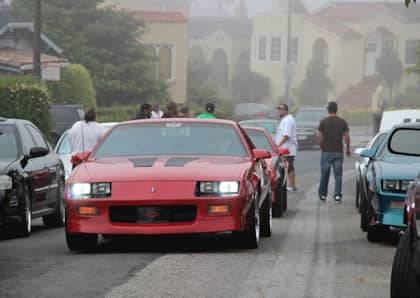The 1970 AMC Rebel The Machine Stood Up To Detroit's Muscle Car Bullies
American Motors Corporation spent much of the 1960s playing catch-up against the Big 3 when it came to product development, mostly due to not having the same level of resources when it came to designing and engineering new automobiles. When it did make it to market, however, it often provided a unique, and enticing alternative to what Ford, Chevy and Mopar were offering.

The 1970 AMC Rebel The Machine is a perfect example of the company doing the best it could with what resources it had. Far from being an afterthought, The Machine was a bonafide muscle car that could stand toe-to-toe with the best that Detroit could bring to a street fight. It may have been too short a season for the star-spangled boulevard warrior, but it made an impression that's still felt today by collectors and classic performance car fans.
Let's Not Make It TOO Obvious…
The AMC Rebel was already a familiar face in drag racing by the end of the 1960s, as American Motors saw the NHRA as a way to get in front of the young, performance-seeking crowd that were increasingly spending their disposable income on high-output street machines. In particular, the Rebel was competitive in the funny car classes, helping the brand carve out a reputation for winning at the track.

When it came time to translate that momentum into a production car, the end result was about as subtle as a nitro-powered dragster. The Machine was introduced in a U-S-A-inspired red, white and blue livery that reflected the name of its manufacturer and celebrated the over-the-top color schemes of the muscle car era. While later on in the model year it would become possible to order a single-color The Machine, early editions were all stripes and swoops with a big blue hood scoop that incorporated an external tachometer. (If you waited, you also benefited from an injection-molded plastic scoop rather than the fiberglass units found on the first batch of Rebels).
More Than Quick
Concealed beneath its early-for-the-bicentennial colors was AMC's hottest-ever engine. The 390 cubic inch V8 offered by The Machine shared much of its internals with the same unit found in the hot AMX two-seater, but improved breathing (via a unique exhaust and intake setup) helped boost its output to 340 horsepower and an impressive 430 lb-ft of torque. A four-speed manual with a Hurst grip was standard, with an automatic available as an option, and you could also stuff a 3.91:1 gear into the rear differential (or, if you were really brave, a 5.00:1) along with an optional limited-slip setup.

The rest of the Rebel's package was standard muscle car fare, albeit with standard disc brakes up front to go with its heavy-duty suspension package and upgraded cooling system. When flogged, The Machine could zip through the quarter mile in just a tick over 14 seconds, which was quick compared to rivals like the Plymouth Road Runner and the Chevrolet Chevelle SS. If that wasn't fast enough, then owners could turn to their local AMC dealer for a long list of a la carte upgrades that boosted engine output to 400 horses and purportedly dropped quarter mile times into the 12 second range.
One And Done, Again
Like many of its one-off performance vehicles, including the Hurst SC/Rambler that came before it, The Machine was only produced for a single year before the name, and the concept, were retired. After selling just over 2,600 units, The Machine would be retired along with the entire Rebel line, which was replaced by the not-nearly-as-exciting Matador for 1971.

In terms of price, the AMC Rebel The Machine was just a tad more expensive than a Pontiac GTO, which presented decent value, if a little less brand recognition, for muscle car buyers. If the AMC had been able to introduce The Machine earlier on in the 1960s, or if it had been paired with the SC/Rambler as a one-two performance punch, then perhaps it might have played a larger role in the pop culture psyche of the times. As it was, AMC had tried to bring a more sinister, blacked-out The Machine concept to dealers in 1968, but labor unrest and management squabbles would derail much of the company's efforts and keep it from pushing more aggressively into the youth market.

Spiritually, The Machine would live on as a ghost of its former self. Matador buyers could spec a 'The Machine' trim level of the car with a 401 cubic inch, 330 horsepower V8, but it was missing both the visual panache and cachet of the Rebel. Only a handful were ever ordered, and AMC's performance torch was fully passed on to the Javelin and its AMX sibling for the remainder of the automaker's existence.
Curious about other obscure cars from the muscle era? Check out our list of high performance classics you might not be familiar with.











